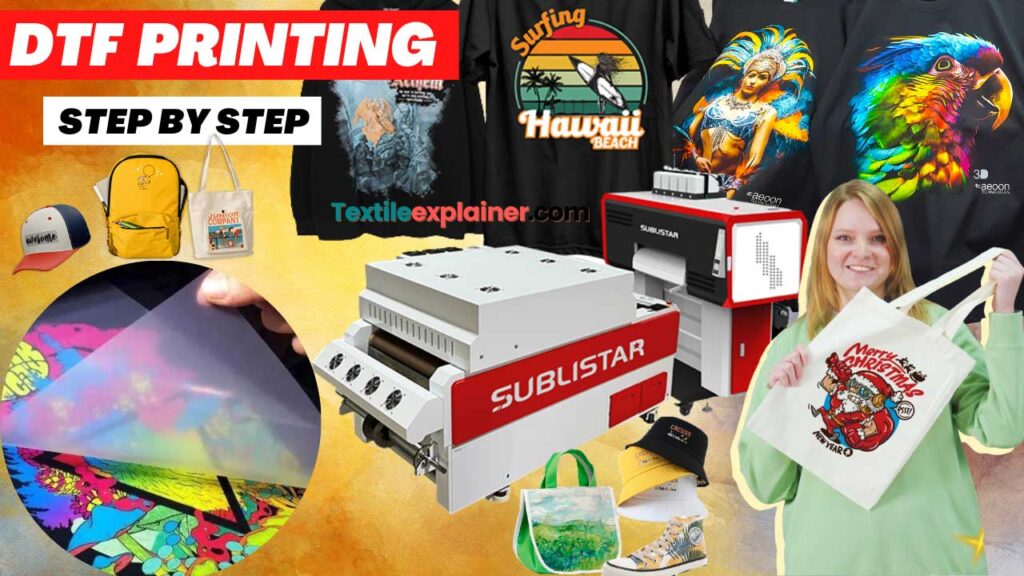DTF Printing Mastery: Elevate Your Textile Creations with Direct-to-Film Technology
DTF Printing Mastery: Elevate Your Textile Creations with Direct-to-Film Technology
Blog Article
Ultimate Guide to DTF Printing Strategies for Sensational Textile Styles
Getting started on the journey of mastering DTF printing strategies can open up a world of opportunities for developing visually fascinating textile styles. In this guide, we will explore the intricate information of DTF printing, from realizing the essential basics to unraveling progressed color methods that can raise your styles to brand-new heights.
Comprehending DTF Printing Essentials
DTF printing, a procedure that includes moving styles from an unique movie to fabrics utilizing warmth and pressure, develops the foundation of fabric printing methods. The initial step in DTF printing involves developing or picking a layout that will be printed onto the fabric.
As soon as the layout is printed on the movie, it is after that very carefully put onto the fabric, ensuring appropriate positioning and positioning. The next critical action includes applying warmth and stress using a warm press equipment. This process turns on the dyes or pigments on the film, creating them to sublimate and bond with the fabric fibers completely. The outcome is a sensational, resilient fabric style that is washable, versatile, and immune to fading. On the whole, comprehending the basics of DTF printing is essential for understanding this modern-day textile printing strategy.
Picking the Right Fabric Materials
Having actually established the fundamental concepts of DTF printing techniques for textile styles, the following critical factor to consider hinges on choosing the appropriate textile products to match this cutting-edge procedure efficiently. The success of a DTF print mostly relies on the compatibility in between the selected material and the printing method. When selecting fabric products for DTF printing, it is vital to consider the textile's composition, weave, and texture. Fabrics that work well with DTF printing consist of polyester blends, spandex, nylon, and other artificial materials. These textiles usually have a smooth surface that enables detailed and vivid prints. In addition, the stretchability of these materials can accommodate the warm transfer procedure associated with DTF printing without distorting the design. It is recommended to prevent all-natural fibers such as cotton or silk, as they may not generate the very same level of print quality and resilience. By picking the appropriate fabric products, developers can make the most of the possibility of DTF printing to create sensational and resilient fabric designs.

Mastering the Printing Process
To succeed in DTF printing techniques for textile styles, grasping the printing procedure is essential for attaining constant and high-grade results. The printing process in DTF includes a number of vital actions that call for accuracy and attention to detail. Preparing the artwork for printing is essential. This includes making sure the layout is correctly sized and positioned for the textile. DTF Printing Next off, the style is published onto an unique DTF film utilizing a suitable printer with the appropriate setups to achieve ideal shade vibrancy and quality (DTF Printing). As soon as the design is published, it is then moved onto the textile using a heat press device. The temperature level, stress, and period of heat application should be meticulously controlled to make sure proper bond of the design to the fabric. In addition, mastering the peeling off procedure after heat pressing is essential to stop any type of damage to the style or material. By developing each of these action in the printing procedure, developers can constantly produce sturdy and sensational textile layouts with DTF printing methods.
Enhancing Designs With Color Strategies

Additionally, exploring with color gradients can bring a sense of motion and fluidity to the style. By blending colors perfectly, a gradient effect can be accomplished, adding a modern and dynamic touch to the fabric layout. In addition, making use of shade blocking techniques can create bold and striking visuals by comparing various strong colors in distinct sections of the layout.
Moreover, incorporating metallic or neon shades can provide a distinct and captivating aspect to the fabric design, making it stand apart and exhibit a sense of vibrancy. When strategically applied, these color strategies can elevate the overall visual allure of fabric designs, making them more captivating and remarkable.
Troubleshooting Common DTF Printing Issues
After exploring various color methods to improve textile styles, it is crucial to Your Domain Name address typical DTF printing problems that might emerge during the production process. In addition, concerns with image clarity and sharpness can occur due to low-resolution photos or incorrect printing methods. By being conscious of these usual problems and carrying out the essential troubleshooting actions, you can boost the general quality of your DTF published fabric styles.
Conclusion
In final thought, mastering DTF printing strategies is vital for producing stunning fabric styles. With practice and attention to information, one can develop stunning and unique fabric layouts making use of DTF printing methods.
Styles))))
DTF printing, a process that involves moving styles from a special movie to fabrics making use of warm and stress, develops the foundation of fabric printing methods.Having actually developed the foundational principles of DTF printing methods for fabric designs, the following crucial factor to consider exists in selecting the ideal textile materials to enhance this innovative procedure effectively. By picking the best fabric materials, designers can maximize the capacity of DTF printing to produce stunning and long-lasting fabric this post layouts.
To excel in DTF printing techniques for textile designs, mastering the printing process is vital for accomplishing high-quality and consistent results. DTF Printing. By honing each of these steps in the printing process, designers can consistently produce stunning and durable fabric layouts with DTF printing strategies
Report this page